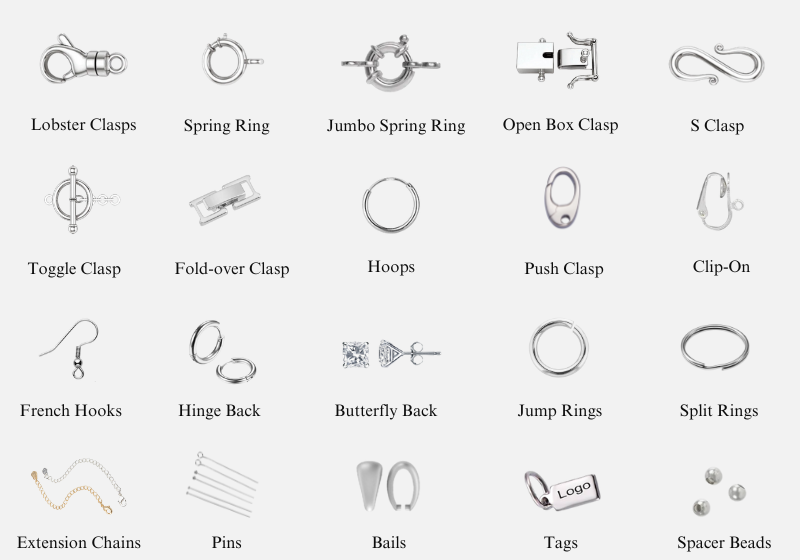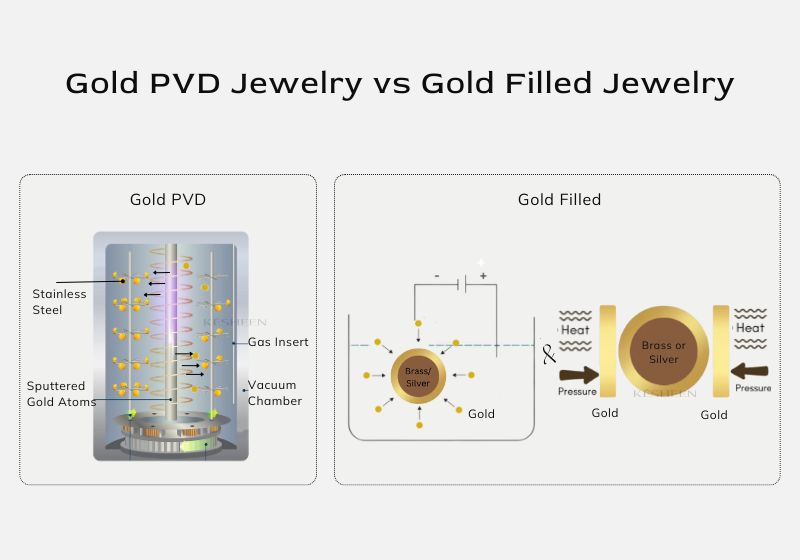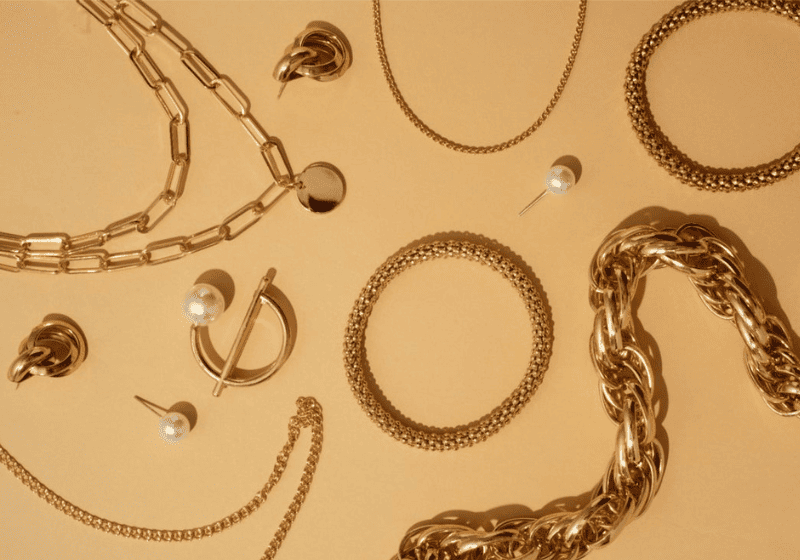Jewelry findings are the tiny yet essential components that help assemble and secure various jewelry pieces. From necklaces and bracelets to earrings, understanding necklace clasp types, jewelry connector types, earrings clasp types, and other findings is crucial for durability, comfort, and style.
This guide covers all the types of jewelry findings you need to know, including their purposes, usage, and practical tips for beginners and professionals alike.
What Are Jewelry Findings?
Jewelry findings are the small components that hold a jewelry piece together. Common jewelry findings include clasps, jump rings, earring hooks, bails, connectors, among others. Despite their small size, they play a significant role in securing and enhancing jewelry designs.
Understanding what are jewelry findings helps artisans select the right pieces to achieve a polished, professional finish, ensuring both aesthetic appeal and long-lasting wearability in necklaces, bracelets, earrings, and other accessories.
Common Metals Used in Jewelry Findings
The metal used affects durability, appearance, and hypoallergenic properties. Below are some of the most popular metals used for jewelry findings.
| Metal | Composition / Notes | Best Use / Pros |
| Stainless Steel | 304 or 316L surgical-grade | Highly durable, tarnish-resistant, hypoallergenic |
| Sterling Silver | 92.5% silver + 7.5% copper | Affordable, classic look, suitable for intricate findings |
| Brass | Copper + Zinc | Malleable, gold-like appearance, cost-effective |
| Gold (14K/18K) | Gold + copper, silver, or zinc | Luxurious finish, hypoallergenic, tarnish-resistant |
Categories of Jewelry Findings
Understanding the categories of jewelry findings will help you make the right choice for your jewelry projects. Here are the three categories of findings:
- Functional Findings
Functional findings are essential for securing and supporting jewelry pieces. These components are primarily useful and practical, providing the necessary connections to make the pieces wearable. They include clasps, jump rings, earring hooks, bails, and connectors.
- Decorative Findings
Decorative findings are used to enhance a jewelry piece’s visual appeal by adding unique design elements. Some of these findings include bead caps, chandelier components, filigree embellishments, and decorative bails.
- Hybrid Findings
Hybrid findings serve both functional and decorative purposes in jewelry design. These include toggle clasps, ornate bails, and decorative connectors, which provide the necessary structural support and connections for jewelry pieces while enhancing aesthetics.
Common Jewelry Clasps Types
A jewelry clasp is a small mechanism that fastens necklaces, bracelets, or anklets, providing security and functionality. These necklace clasp types and jewelry closure types are essential for every jewelry piece:
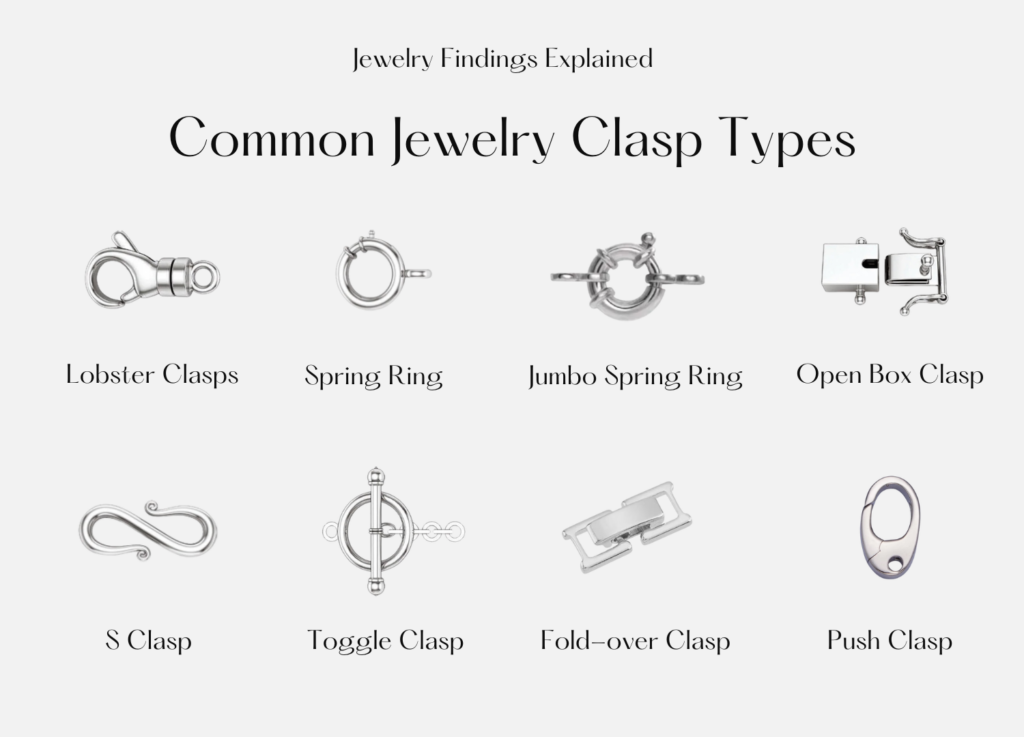
Lobster Clasp
Lobster claw clasps are one of the most commonly used types of jewelry findings. They are popular for their spring-loaded mechanism, usually found in necklaces and bracelets. Its lobster claws open when a small lever is pushed and close automatically when released, preventing accidental unfastening and ensuring security.
Spring Ring
Spring ring clasps are similar to lobster claws in their operation. They have circular fasteners with spring-loaded mechanisms inside. These jewelry findings are lightweight and are often used in delicate pieces where it’s important to have a small clasp. While spring rings offer security, they are a bit challenging to operate and require some skill to open and close.
Jumbo Spring Ring
A jumbo spring ring clasp works like a regular spring ring but is larger, making it easier to handle. These jewelry clasps are often used in heavier jewelry pieces as their larger diameter provides extra security and ensures the piece stays fastened. Jumbo spring rings are a practical choice for those seeking a balance between elegance and functionality.
Open Box Clasp
The open box clasp consists of a small box with a metal tab that clicks into place. This clasp provides a secure hold and is often used in luxury or vintage jewelry pieces. Box clasps can be adorned with decorative elements, like gemstones or engravings, blending seamlessly with the jewelry aesthetics.
S Clasp
S-clasps are connectors shaped like an ‘S’ that can be easily opened and closed. It works by hooking one end into a jump ring or chain loop, making it secure yet easy to open. This jewelry connector is often used in bracelets and necklaces, and a preferred choice for those who appreciate artistic, handcrafted pieces.
Toggle Clasp
A toggle clasp consists of a T-shaped bar that fits into a circular or decorative loop. The bar is inserted through the ring to hold the jewelry piece together These jewelry clasps types work best with heavier jewelry pieces as their weight keeps the clasp in place. They are popular in statement jewelry and add a decorative element to your design.
Fold-over Clasp
A fold-over clasp is a hinged mechanism that provides designs with a stylish closure. It features a small metal flap that folds open and close, snapping in place to create a secure look. This clasp is ideal for beaded strands and link chain designs, as they are easy to open and close.
Push Clasp
Push clasps are also known as “slide” or “snap” clasps. They consist of two parts that slide or push together and operate with a simple spring friction mechanism that slides apart to open. These jewelry findings provide a seamless look while ensuring security, making them great for multi-strand necklaces and bracelets.
Common Earrings Findings Types
Earring findings attach earrings to the ear while supporting the earring’s design and weight. Here are some earring clasp types and earring findings types:
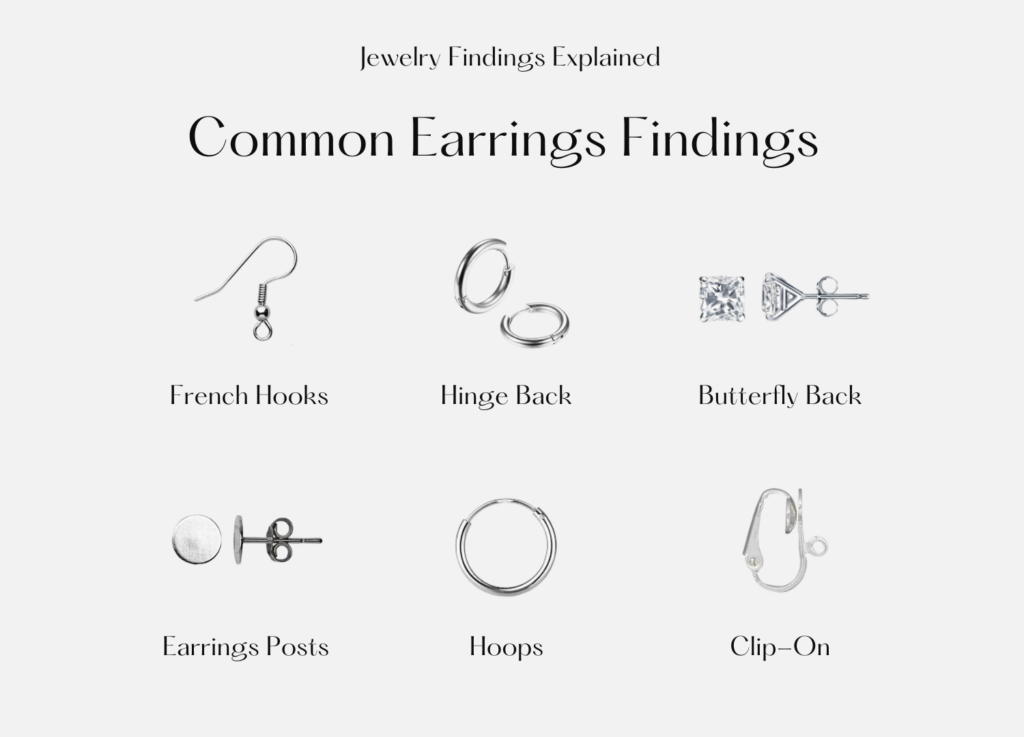
French Hooks (Ear Wires)
French hooks, also known as ear wires, are curved earring findings that pass through the earlobe without a back closure. These very common findings are popular for dangling and drop earrings due to their ease of use and versatility. The open design of French hooks allows for easy wear but may require rubber stoppers for extra security.
Hinge Back
Hinge back earrings feature a hinged mechanism that snaps into place, securing the earring comfortably on the earlobe. This style is commonly found in hoop and huggie earrings, providing a secure hold without the need for additional backs. They are often integrated with durable metals like gold, silver, or 316L stainless steel jewelry.
Butterfly Back
Shaped like a butterfly, these earring findings are small metal pieces that slide onto earring posts to hold them in place. Butterfly backs provide a secure, comfortable fit while allowing for easy removal. Their simple yet effective design makes them a popular choice, though they can loosen over time from frequent use.
Earring Posts
Earring posts are straight metal rods designed to pass through the earlobe and secure with earring backs. Common earrings backs include butterfly backs, hinge backs, latch backs, and screw backs. This jewelry component is commonly used for stud earrings and provides a straightforward attachment method.
Hoops
Hoop earrings feature a circular or semi-circular design that loops through the earlobe, often secured with hinge backs, latch closures, or wire hooks. They are available in various sizes and styles, ranging from small hoops to large statement pieces. Hoop earrings are popular for their classic designs and are a preferred choice for both casual and formal occasions.
Clip-On
Clip-on earrings are designed for individuals without pierced ears, using a spring-loaded clip or screw-back mechanism to keep the earring in place. They provide a comfortable, adjustable fit and come in various styles, from studs to elaborate dangling designs. Modern versions often feature padded backs to enhance comfort while maintaining a secure hold.
Jewelry Connectors and Fasteners
Connectors join jewelry components to maintain structural integrity and versatility. These jewelry connector types are commonly used:
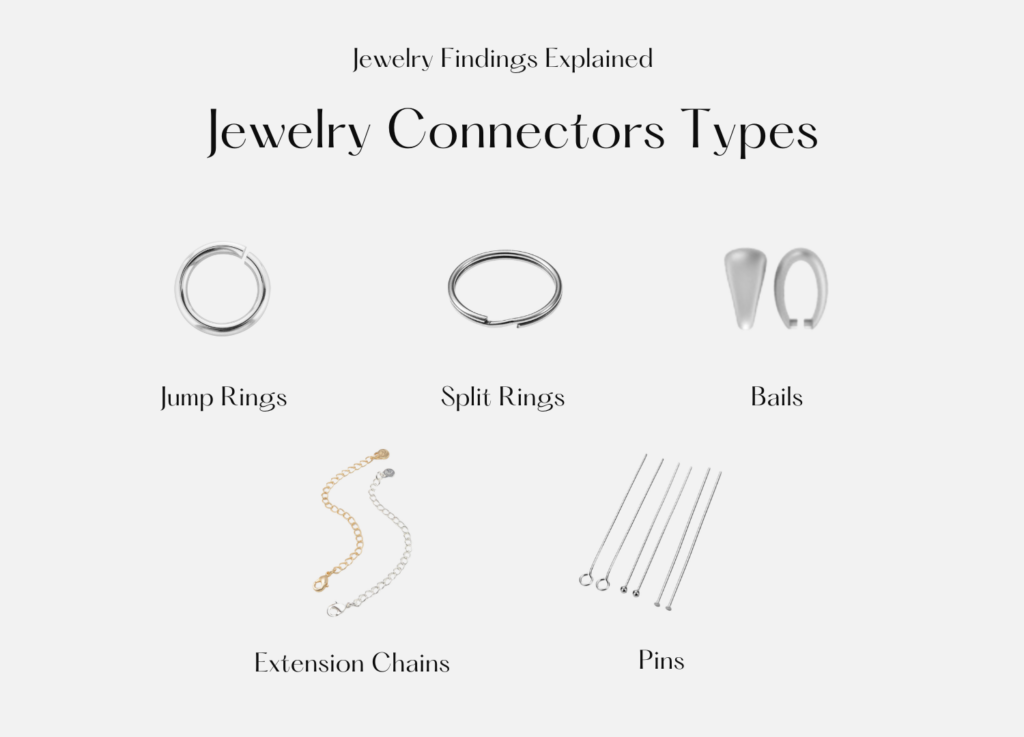
Jump Rings
Jump rings are one of the most basic findings in jewelry making. They are small metal rings used to connect components such as clasps, pendants, earring dangles, and other components. These connectors come in various sizes and thicknesses, and can be opened or soldered.
Split Rings
Split rings feature a double-looped design and provide more security than jump rings. They are ideal for keychains, charms, and heavy jewelry where additional strength is required. These connectors hold part of the coil open when sliding the ring onto the connecting piece.
Extension Chains
Chain links can be used as connectors in jewelry designs, allowing for the creation of adjustable lengths and multi-strand pieces. Made from high-quality materials by a custom jewelry manufacturer, extension chains ensure reliable connections while complementing various jewelry designs.
Pins
Pins are crucial in jewelry making, serving as both connectors and decorative elements. Common pins include head pins, eye pins, and ball pins. Head pins have a flat or decorative head that is ideal for creating dangles and pendants, while eye pins feature a looped end perfect for linking beads or charms. Alternatively, ball pins include a small ball tip, adding a stylish touch to designs.
Bails
Bails are connectors that attach pendants or charms to chains and necklaces. Pendant bails offer a firm, stylish attachment, while glue-on bails have a flat surface for adhesive application. Pinch bails use a hinged mechanism to grip pendants firmly. Bails enhance the jewelry’s aesthetics without compromising on functionality.
Special Jewelry Findings
Some findings add decoration, branding, or extra security. These special jewelry findings include:
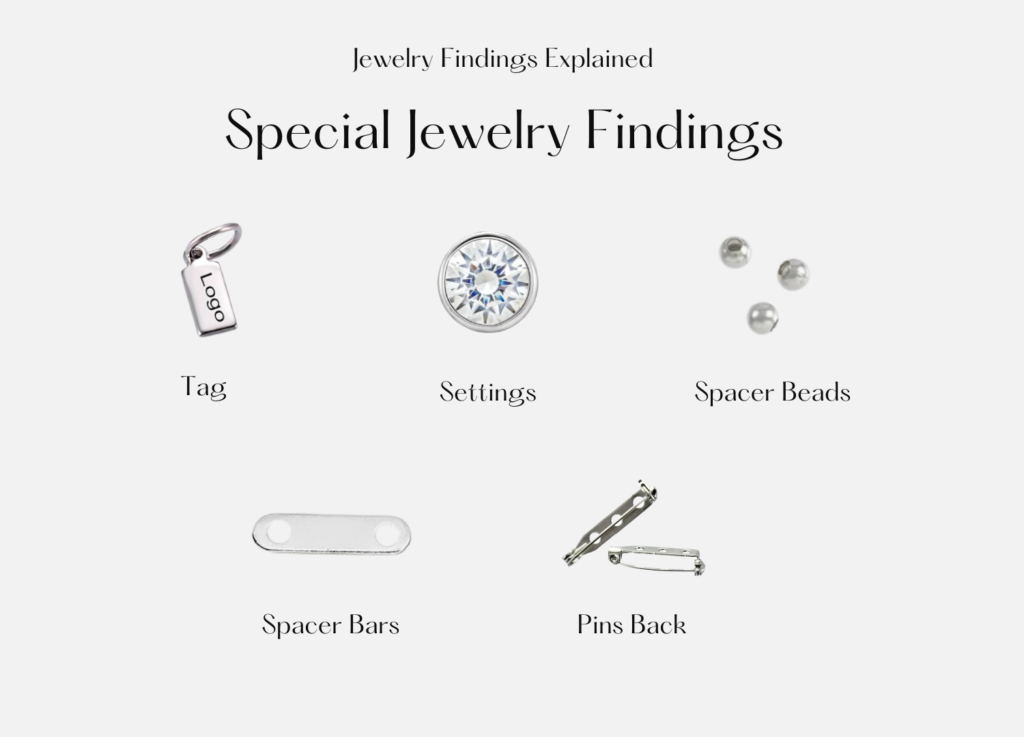
Tag
Tags are unique jewelry findings used for branding, personalization, and authentication. These small metal plates are often engraved with logos or initials, adding a professional touch. They boost brand identity, verify material authenticity, and contribute to the overall design and value of high-quality jewelry pieces.
Settings
Settings hold gemstones, crystals, or other decorative elements in place. Bezel settings surround the stone with a metal rim for durability and everyday wear. Prong settings use small metal prongs to hold the stone, maximizing light reflection. Channel settings secure stones between metal walls, offering a sleek, modern design.
Spacer Beads
Spacer beads are special jewelry findings used to separate larger beads and components. They are also used to highlight individual beads, adding balance and beauty to the design. These jewelry findings are available in a variety of materials, including metal, glass, and plastic.
Spacer Bars
Spacer bars are used to keep your beads separated in multi-strand bead designs. They can blend seamlessly into your beaded design, or stand out as a decorative element to add design to your piece.
Pin Backs
Pinbacks are essential special jewelry findings designed to secure brooches, badges, and decorative pins. Available in styles like butterfly, rubber, and locking clasps, they provide stability and easy fastening, ensuring a secure and comfortable fit for various jewelry and accessory designs.
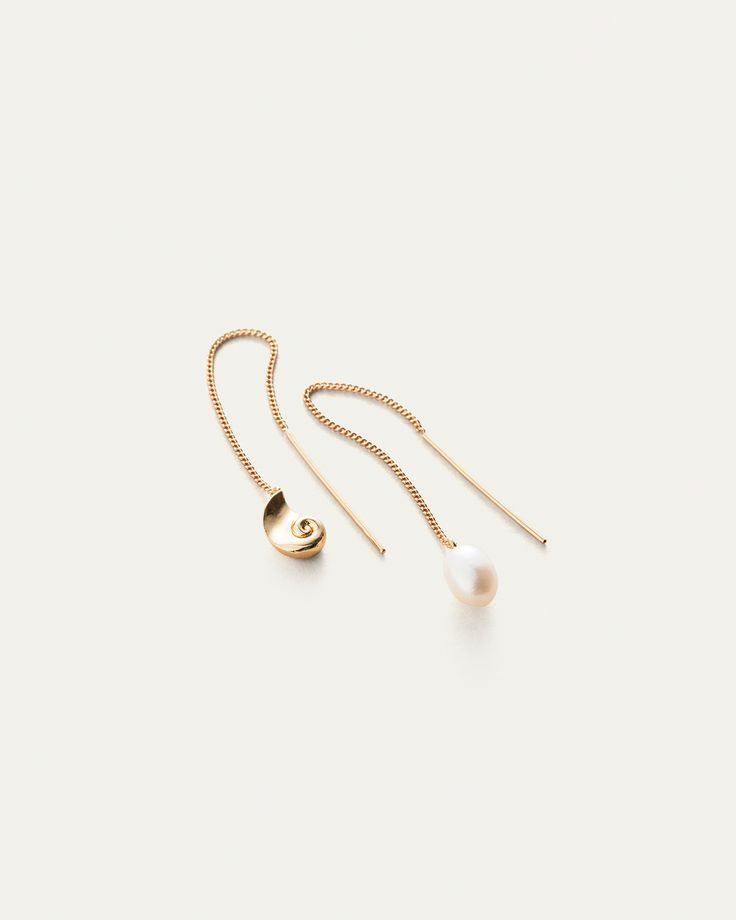
How Jewelry Findings Affect Jewelry Quality?
Investing in high-quality findings ensures better design, durability, and customer satisfaction. Here are some reasons why these small components are important for brands:
- Durability & Security
High-quality findings made from sterling silver, gold, or stainless steel resist bending, breaking, and wear, ensuring long-lasting jewelry. Sturdy clasps and jump rings keep pieces intact, while weak or low-quality findings can compromise structure and lead to component loss.
- Comfort & Wearability
Findings that touch the skin—like earring wires and necklace clasps—should have smooth edges and comfortable shapes. Hypoallergenic materials such as stainless steel and sterling silver reduce irritation, allowing extended, comfortable wear.
- Material Matters
Is stainless steel good for jewelry materials? Yes, metals like stainless steel, sterling silver, gold-filled, and brass offer strength, corrosion resistance, and visual appeal. Non-metal findings—plastic, wood, resin—add creative versatility but may lack durability. Stainless steel is particularly ideal for its tarnish resistance, hypoallergenic properties, and structural integrity.
- Aesthetic Consistency
Well-made findings feature smooth finishes, uniform shapes, and precise detailing, blending seamlessly with the design. Poorly crafted findings with rough edges or inconsistent sizes can diminish both beauty and perceived quality.
What Defines High-Quality Jewelry Findings?
- Functionality
High-quality jewelry findings should be user-friendly and designed for ease of use. Clasps should open and close smoothly without requiring excessive force, while earring posts and hooks should provide a secure yet comfortable fit.
- Strength of Materials
Durable materials like 316L stainless steel are essential for long-lasting, hypoallergenic jewelry findings. This high-grade stainless steel is resistant to tarnish, corrosion, and skin irritation, making it ideal for earring posts and other skin-contact components.
- Strength & Reinforced Construction
Superior jewelry findings should withstand daily wear without breaking. Secure closures, reinforced connectors, and soldered jump rings, as well as using quality control checklists for all jewelry types ensure durability and prevent accidental detachment.
How to Ensure Hypoallergenic Earrings While Balancing Cost?
Hypoallergenic earrings prevent skin irritation, with 316L stainless steel being the best but more expensive than 304 stainless steel. To balance cost and safety, use 304 stainless steel jewelry findings for the earring body and 316L for the posts. This ensures durability, affordability, and minimized allergic reactions while keeping production costs minimal.
How to Keep a Tennis Necklace From Flipping Over?
- Use Powder Metallurgy Molding
Necklaces made using pre-made molds available on the market tend to have this problem due to their design and weak structure. To address this, we use custom-made molds through powder metallurgy to ensure precise craftsmanship and superior durability. This makes the jewelry more secure, delicate, and resistant to flipping or breakage.
- Adjust the Structure & Angle
Improper alignment can cause instability, making the necklace flip frequently. To prevent this, we adjust the stone settings at a precise 45-degree angle, ensuring that each stone always faces upward. This strategic positioning provides better balance, allowing the necklace to rest securely around the neck without flipping.
- Pick the Right Clasp Types and Position
Selecting the right type of clasp can also make a significant difference in how to keep tennis necklace from flipping over. A sturdy, well-crafted clasp offers better weight distribution, helping to maintain the balance to prevent flipping. Clasps like lobster claws or box clasps are excellent choices for heavier necklaces.
- The Balance of the Chain and the Pendant
Achieving the right width ratio between the chain and pendant is essential to affect the balance of the necklace. If the width ratio is off, it can create instability. Hence, a well-balanced design ensures an even-weight arrangement, allowing the necklace to sit properly without constant adjustments.
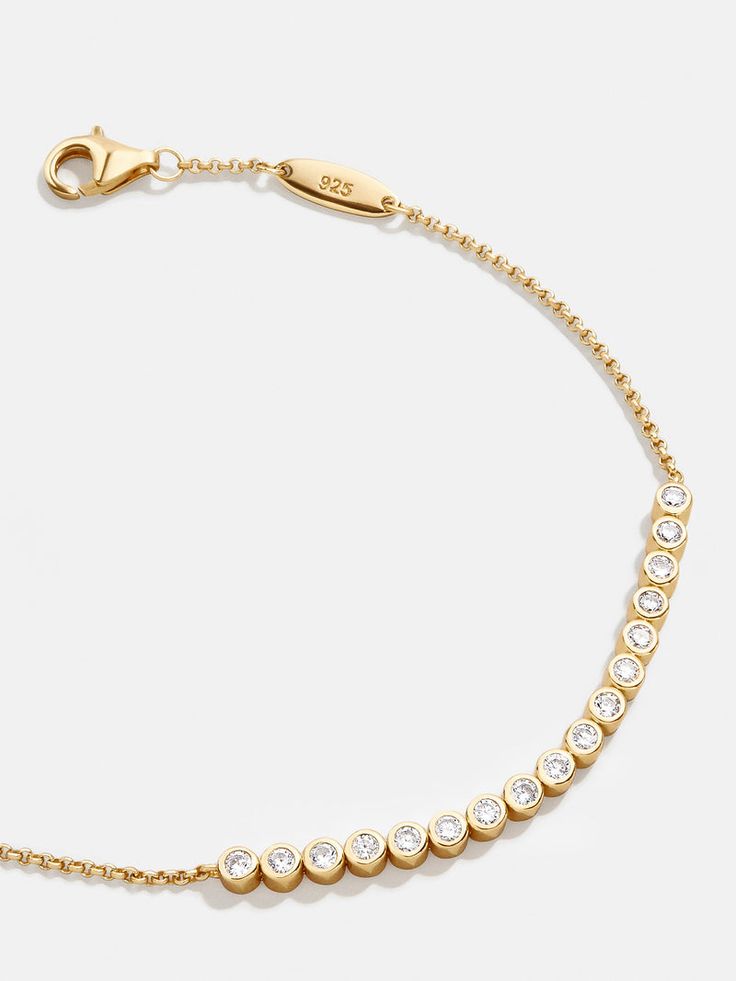
How to Choose the Right Jewelry Findings For Your Jewelry?
To choose the right types of jewelry findings for your jewelry, here are some factors to consider:
Type of Jewelry
The type of jewelry determines the appropriate findings to be used. For example, earrings require earring wires or posts, while necklaces and bracelets need strong clasps for stability. Before choosing, it’s important to select the right findings that are suitable for that jewelry piece.
Durability and Strength
Selecting strong clasps, sturdy fasteners, and reliable connectors is important for your jewelry’s longevity and security. When made from durable materials, findings help maintain structural integrity and keep jewelry functional without compromising design or quality.
Design and Aesthetics
Jewelry findings should seamlessly blend with the design and aesthetics of your jewelry piece. Thoughtfully choosing clasps, hooks, and connectors ensures a seamless look that complements the overall jewelry design and visual appeal.
Allergies and Skin Sensitivities
Hypoallergenic findings made with materials like 316L stainless steel, titanium, or sterling silver reduce irritation and discomfort. It’s essential to prioritize skin-friendly metals to ensure comfort for individuals with allergies or sensitivities.
What to Notice When Designing With Jewelry Findings in Mind?
There are some elements to pay attention to when crafting jewelry findings. Below, we explore how these elements impact jewelry design and wearer experience.
Considering the Weight
Proper weight distribution of jewelry findings makes the jewelry piece wearable and durable. A necklace clasp should be firm enough to support the pendant’s weight, balancing strength and comfort. Jewelry findings for earrings should be lightweight to prevent discomfort yet sturdy enough to hold them securely.
Ease of Use
Jewelry findings should be user-friendly, ensuring a hassle-free experience for wearers. Clasps must be easy to open and close, while earring backs should offer a secure fit without being difficult to remove. Moreover, easy-to-use findings enhance convenience, reduce customers’ complaints, and improve overall satisfaction with the jewelry piece.
Compatibility
Jewelry and findings should be selected to complement each other, and protect delicate accessories like gemstones and cabochons. For gemstone designs, prong settings safeguard diamonds, while bezel settings shield cabochons from damage.
Conclusion
Jewelry findings are the unsung heroes of every piece, balancing function, durability, and aesthetics. By understanding necklace clasp types, earring findings types, and connector options — and considering the jewelry type, jewelry material, and design requirements — jewelers and enthusiasts can choose the perfect jewelry findings to create pieces that are secure, beautiful, and long-lasting.
